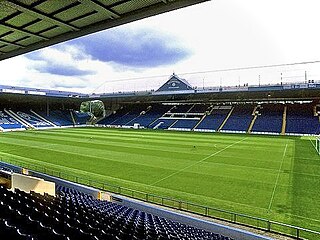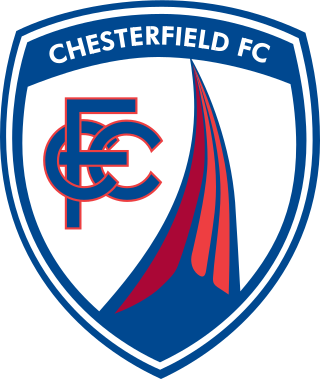
Hillsborough Stadium is a 39,732-capacity association football stadium located in Owlerton, a north-western suburb of Sheffield, Yorkshire, England. It has been the home of Sheffield Wednesday since its opening in 1899.

Sheffield Wednesday Football Club is a professional association football club based in Sheffield, South Yorkshire, England. The team competes in League One, the third tier of the English football league system. Formed in 1867 as an offshoot of The Wednesday Cricket Club, they were known as The Wednesday Football Club until 1929.

Sheffield United Football Club is a professional football club in Sheffield, South Yorkshire, England, which competes in the EFL Championship. They are nicknamed "the Blades" due to Sheffield's history of cutlery production. The team have played home games at Bramall Lane since their formation. For most of the club's history, United have played in red and white striped shirts with black shorts. Their main rivals are Sheffield Wednesday, with whom they contest the Steel City derby.

Don Valley Stadium was a sports stadium in Sheffield, South Yorkshire, England. The venue, which was completed in September 1990, hosted the 1991 World Student Games. It was designed by Sheffield City Council's Design & Building Services and named after the nearby River Don. It was demolished in 2013.

Sheffield Football Club is an English football club from Sheffield, South Yorkshire. They currently compete in the Northern Premier League Division One East. Founded in October 1857, the club is recognised by FIFA as the oldest existing club still playing football in the world. Sheffield FC initially played games under the Sheffield Rules and did not officially adopt the new FA rules until 1878.

Rotherham United Football Club, nicknamed The Millers, is a professional football club based in Rotherham, South Yorkshire, England, which compete in the EFL Championship. The club's colours were initially yellow and black, but changed to red and white around 1930. Since 2012 they have played home matches at the New York Stadium, having briefly moved to the Don Valley Stadium from their original home at Millmoor in 2008.

Chesterfield Football Club is an English professional association football club based in the town of Chesterfield, Derbyshire, England. The team competes in the National League, the fifth tier of the English football league system. Chesterfield play their home games at the 10,500 capacity Technique Stadium, having moved from their historic home of Saltergate during the summer of 2010. Notable former players include record appearance holder Dave Blakey, who played in 617 of Chesterfield's league games, and 162 league goal club record holder Ernie Moss. The club contests numerous local rivalries, most notably with Nottinghamshire club Mansfield Town.

Bramall Lane is a football stadium in Sheffield, South Yorkshire, England, which is the home of Sheffield United.

Sheffield has a long history of involvement in sport. Although cricket was the first organised sport, it has gradually been supplanted by football. Both the main two local football teams grew out of cricket teams. Sheffield can claim many firsts in football the most famous one being Sheffield F.C. being the world's first and oldest football club. Today it has a club in every major team sport in England. Sheffield became the first UK National City of Sport in 1995 and is now home to the English Institute of Sport (EIS).

The Sheffield Eagles are a professional rugby league club that play in the Betfred Championship. The club play their home games at the Olympic Legacy Park (OLP) on the former site of Don Valley Stadium, their former ground. The original club was formed in 1984 and formerly competed in the Super League. The new, current club was formed in 2000 following a merger of the old club with Huddersfield Giants. The old club's biggest achievement was winning the Challenge Cup in 1998. Sheffield were the inaugural winners of the 1895 Cup, after they beat Widnes at Wembley Stadium on 24 August 2019.

The Steel City Derby is a local derby that takes place between Sheffield United and Sheffield Wednesday, the two professional football league teams based in the city of Sheffield, England. It is widely considered to be one of the biggest derby matches in English football.

Owlerton Stadium, also known as Sheffield Stadium, is a purpose-built speedway track built in 1929 which also hosts greyhound racing The track is in Owlerton near Hillsborough in Sheffield, South Yorkshire, England. Greyhound racing takes place on Tuesday, Friday and Saturday evenings and every Monday and Thursday afternoon. There is a modern glass-fronted Panorama Restaurant accommodating up to 300 people, executive suites, fast food facilities and a number of bars.

The history of Sheffield Wednesday F.C., an English football club from Sheffield, dates back to the club's establishment in 1867. The club would see early regional success followed by a rocky transition to professionalism. Although it has spent the majority of its Football League years in the top flight, its position within the league has varied from the very top to almost slipping to the fourth tier.

Sheaf House is a former home ground of The Wednesday Football Club and was located near the centre of Sheffield, South Yorkshire, England. The club started to use the ground after leaving Myrtle Road in 1877 and it remained their main 'home' ground until 1880. At that point most home matches switched to Bramall Lane, however Wednesday continued to play some games at Sheaf House until Olive Grove was opened in 1887.

Thomas Henry Crawshaw was a professional footballer who played almost his entire League career with Sheffield Wednesday. Crawshaw was a centre-half whose career lasted from 1894 to 1909 during which time he played a total of 492 games in all competitions, scoring 27 goals. Crawshaw has gone down in the annals of Sheffield Wednesday as one of the key figures in the early history of the club. In the late 19th and early 20th centuries he appeared in The Wednesday side which lifted the FA Cup on two occasions and won the Football League First Division title twice. He is the only Sheffield Wednesday player to win two FA Cup winners medals with the club. He appeared for the England national football team on ten occasions.
The 1867–68 Season was Sheffield Wednesday F.C.'s first season after being formed on 5 September 1867. For this first season of their existence "The Wednesday" as they were called played their home matches on an open field known as "high field" in the present Highfields area of Sheffield. The actual location of the ground was on Upper Colver Road which no longer exists but was situated on the present day site of the Highfields Library which stands near the junction of London Road and Abbeydale Road.
Sheffield United Cricket Club is the first sports club or association in England to bear the word, ’United’ in its name, common amongst association football clubs in England today. Sheffield United Cricket Club was formed in 1854, by several local cricket clubs in Sheffield uniting, thus the name. The inclusion of ‘United’ in the name also distinguished it from the existing and longer-established Sheffield Cricket Club.
The 1890–91 season was Sheffield United's second, and their first and only season playing in the newly formed Midland Counties League, as the club sought to establish itself as a major footballing force. The team was selected by the club's football committee and coached by a trainer, but day-to-day affairs were overseen by club secretary Joseph Wostinholm. The club saw a large influx of players during the season as it continued to bolster its numbers with amateurs loaned or signed from other teams in the local area, a policy that resulted in an unsettled side, indifferent league results, and a mid-table finish.
The 1891–92 season was the third in existence for Sheffield United. This was their first season playing in the recently formed Northern League as the club sought to establish itself as a major footballing force. The Blades had a reasonably successful season, finishing third in the league, and registering some comprehensive victories along the way. They improved on the previous season by reaching the second round proper of the FA Cup and were victorious in the local cup competitions, winning both the Sheffield Challenge Cup and the Wharncliffe Charity Cup for the first time.
Darnall Stadium was a greyhound racing stadium in Darnall, east Sheffield, South Yorkshire.
















